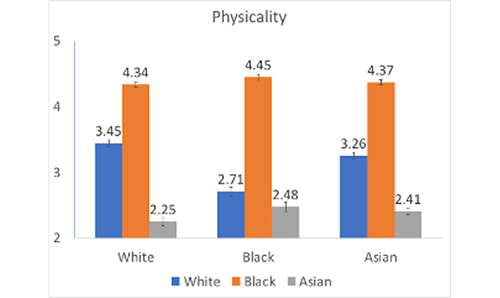Gendered Stereotypes of Race
#StopAsianHate. Do gendered stereotypes of race shape patterns of prejudice and aggression against Asian and Black men?
Manchester China Institute Research Fellow, Dr. Katja Levy is undertaking a unique, comparative study examining philanthropic behaviour in the UK and China.

Spring 2020 witnessed a rise in anti-Asian Covid-related prejudice in the United States. Summer 2020 then witnessed tens of millions of Americans demonstrating in Black Lives Matter #BLM protests following the killing of George Floyd in Minneapolis. In May 2021, a mass shooting in Atlanta that killed six Asian women then galvanized an emerging #StopAsianHate movement.
These racial hate incidents raise a series of questions: Do gendered stereotypes of race shape patterns of prejudice and aggression against Asian and Black men? Might emasculating stereotypes about Asian men (as low in physical strength) encourage anger and opportunistic aggression against them? Might hypermasculine stereotypes about black men (as physically formidable) inflate fear, increasing disproportionate (e.g. lethal) uses of force against them?
The MCI research lab is addressing these questions in a series of studies using a variety of methods, including surveys, experiments, quantitative social media content analysis and qualitative discourse analysis. In Summer 2021, two 2nd year Politics students from The University of Manchester joined the research project through the Q-Step Internship Programme.
Preliminary findings

In an initial study, we found that Black, White, and Asian Americans all stereotyped Blacks as the highest on athleticism and physical strength—and Asians as the lowest. As the bar chart on the right reveals, the differences in these racial stereotypes about physicality were substantial—and consistent across subpopulations.
Related publications
Related publications on the social psychology of globalisation, contact, and intergroup bias
“Similar outgroups: Threatening or likable?” Asian Journal of Social Psychology, 2021. I-Ching Lee, Peter Gries, & Jenny Su.
ABS. Are outgroup members seen as similar to the ingroup perceived to be threatening or likable? The literature has offered two opposing answers. Research on distinctiveness threat suggests that they will be threatening: outgroup members sharing high similarity with the ingroup may blur group boundaries, endangering clear ingroup identity and positive self-regard. The literature on similarity attraction, however, suggests that outgroup members resembling the ingroup should be likable. Taking advantage of common Han ethnicity and Chinese culture, two studies (N1 = 247, N2 = 318) in Taiwan manipulated the degree of similarity between ingroup (Taiwanese) and outgroup (people from the People’s Republic of China), exploring the effects on intergroup attitudes. Study 2 further investigated other potential moderators (Taiwanese identification and source of similarity information). Although Taiwan presents a most difficult case for similarity attraction, it was supported across both studies: similar others were more likable. In particular, the similarity attraction evidence was stronger among pan-Green supporters, especially for those low on Taiwanese identification. Implications for distinctiveness threat, similarity attraction, and 21st century intergroup relations are further discussed.
“When objective group membership and subjective ethnic identification don’t align: Testing theories of intergroup relations in Taiwan,” Group Processes & Intergroup Relations, 21.4 (2018): 615-630. I-Ching Lee, Jenny Su, and Peter Gries.
ABS. When objective group membership and subjective ethnic identification don’t align, which has a greater impact on how people feel towards the groups they affiliate with, and why? Deprived of many distinctiveness markers typically found in intergroup relations (e.g., physical features, obvious status differences), Taiwanese society provides a perfect natural context to explore the impact of objective group membership (Taiwanese nationality) versus subjective ethnic identification (Taiwanese or Chinese) on intergroup bias. Results from representative telephone (N = 1,060) and Internet (N = 500) surveys demonstrated that even among participants with no visible distinctiveness markers or differences in social status, subjective ethnic identification contributed to intergroup bias in favor of Taiwanese over Chinese Mainlanders (main effect). Both self-enhancement (collective self-esteem as Taiwanese) and perceived threat from Chinese Mainlanders helped account for this finding (mediation effects). Implications for intergroup relations are discussed.
“Linking parental socialization about discrimination to intergroup attitudes: The role of social dominance orientation and cultural identification,” Cultural Diversity and Ethnic Minority Psychology, 23.3 (2017): 435-444. Jenny Su, Peter Gries, Lee I-Ching, and Alisia Tran.
ABS. This study investigated the interaction of parental socialization about discrimination and social dominance orientation (SDO) in predicting the cultural identity and intergroup attitudes of the Minnanese, an ethnic group in Taiwan that faced systematic discrimination during the early decades of Chinese Nationalist rule. Because high SDO individuals tend to support group-based dominance, we hypothesized that under high preparation for bias, which may reinforce narratives that place the historically disadvantaged Taiwanese in a subordinate position, Minnanese high in SDO would identify less with Taiwanese and more with Chinese (the historically high-status outgroup) compared with their low SDO counterparts. Method: We examined our hypotheses using a sample of Minnanese (N = 365; 183 women, 182 men; average age = 44.35) who participated in a nationally representative survey of Taiwanese adults. Results: As predicted, among Minnanese exposed to high levels of preparation for bias, those with high SDO expressed greater levels of Chinese identification and more favorable attitudes toward Chinese than their low SDO counterparts (no difference was found in attitudes toward Taiwanese). Among Minnanese exposed to low levels of preparation for bias, SDO predicted neither Chinese nor Taiwanese identity. Moreover, the interaction effect of preparation for bias and SDO on attitudes toward Chinese was mediated by Chinese identity. Conclusion: Using a unique, non-Western sample, this study demonstrated the role that parental socialization about past discrimination, in combination with belief in group-based dominance, plays in the construction of group identity and intergroup attitudes among members of historically disadvantaged ethnic groups.
“Toward a social psychology of globalization.” Journal of Social Issues, 67.4 (2011): 663-676. Chiu, C-.Y., Gries, P., Torelli, C. J., & Cheng, S. Y-y.
ABS. In most parts of the world, globalization has become an unstoppable and potent force that impacts everyday life and international relations. The articles in this issue draw on theoretical insights from diverse perspectives (clinical psychology, consumer research, organizational behavior, political psychology, and cultural psychology) to offer nuanced understanding of individuals’ psychological reactions to globalization in different parts of the world (Australia, Hong Kong, Japan, Mainland China, Singapore, Switzerland, United States, Taiwan). These articles address the questions of how people make sense of and respond to globalization and its sociocultural ramifications; how people defend the integrity of their heritage cultural identities against the “culturally erosive” effects of globalization, and how individuals harness creative insights from their interactions with global cultures. The new theoretical insights and revealing empirical analyses presented in this issue set the stage for an emergent interdisciplinary inquiry into the psychology of globalization.
“When knowledge is a double-edged sword: Contact, media exposure, and American attitudes towards China.” Journal of Social Issues, 67.4 (2011): 787-805. Peter Gries, H. Michael Crowson, & Huajian Cai.
ABS. Globalization affords greater opportunities to learn about foreign peoples than in the past. What impacts do interpersonal contact, media exposure to and knowledge about China have on the American people's China policy preferences? Two large surveys of U.S. citizens were conducted in the summers of 2008 and 2009 to explore whether knowledge about China and prejudice against the Chinese people and the Chinese government would mediate the relationship between contact and media exposure on the one hand, and U.S. China policy preferences on the other. Results show that while knowledge played the expected mediating roles between contact and media exposure on the one hand, and prejudice against the Chinese people on the other, greater knowledge of China was actually associated with greater negativity toward the Chinese government, which in turn contributed to desires for tougher China policies. Both media exposure and interpersonal contact thus had mixed effects on China policy preferences.
Research team
- Peter Gries
- Cong Peng
- Carwyn Morris
- Paton Yam
- Tao Wang
- Elena Keefe
- Ihesinachi Oyouwa Oko-Jaja
